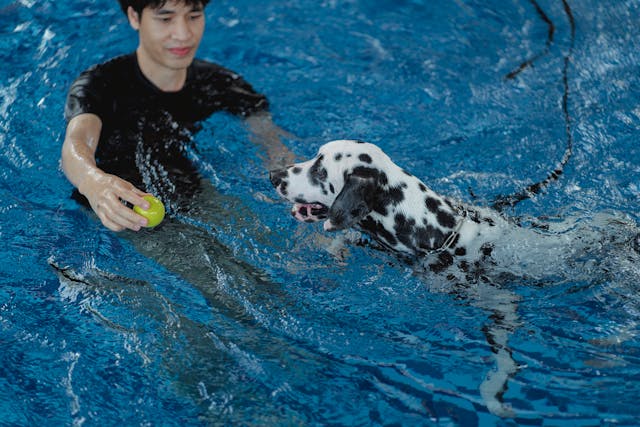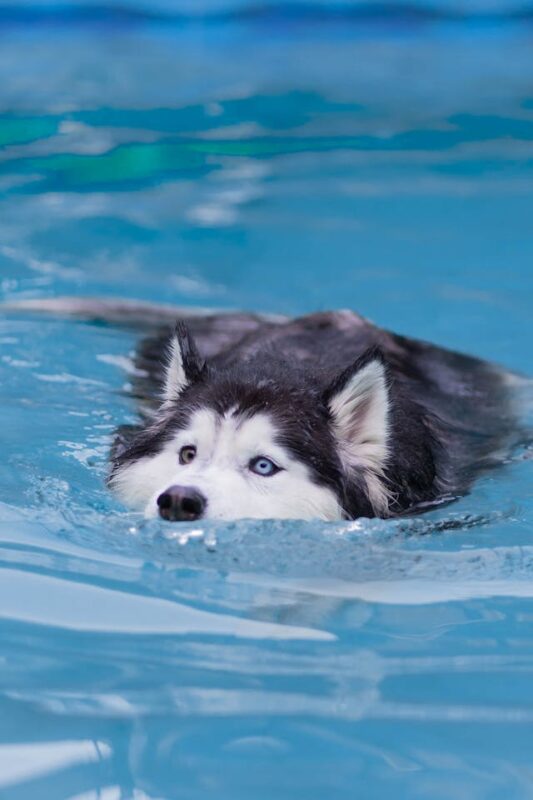Pool Safety Tips for Dogs
Posted: 07/03/2024 | BY: Jenna Bruce | Categories: Dog , Pet care , Top Tips
Summer is officially here and that means spending more time outdoors with family. One of the best – and funnest ways – to stay cool on hot summer days is to splash around in the pool. But can our pups take part in this fun, too? The short answer is yes, but you’ll want to read on for some pool safety tips for dogs!

Making Pooltime Safe For Dogs
As long as pup parents take the necessary precautions, pooltime can be a fun and safe activity for the entire family, four-legged members included! We should mention that you should never force a dog into the pool. Some dogs love being in the water while others have an aversion to it. Only consider the following tips if your pup seems interested or is already jumping in on their own.
With this in mind, here are some considerations before inviting your pup to join you for a swim:
Teach Your Pup to Swim
Just because we’ve named something, the “doggy paddle” doesn’t mean that all dogs are natural-born swimmers. That is a myth. And that’s why your top priority should be to help your dog become comfortable in the water.
Once your dog is more comfortable in the water, give them a few proper swimming lessons. If you have the budget, you could hire a dog trainer with experience in this area for a few lessons. But if not, you can train them yourself.
Start in the shallow end so you can stand and help them float. Most dogs will indeed do the doggy paddle, which means they’ll only use their front paws. But this method produces a lot of splashing and little real movement.
Your job is to hold up the back of your pup’s body, gently, underneath their waste, to keep them from winding up in a vertical position. This will help them start to use their rear paws for paddling as well.

Be sure to use some pawsitive reinforcement and praise your pup. Watch them closely and keep them toward the shallow end until they get the hang of things. This way if they need a break or seem tired you can easily help them out of the pool.
Teaching your dog to swim can really help them get some great exercise. And this can be particularly helpful for older dogs with mobility issues who can’t go on long walks.
Get Them a Life Jacket
You may also want to fit your dog with a life jacket to help keep them afloat during training and even everytime they go into the pool after, just as a safety precaution. Younger pups, large breeds and senior dogs can tire more easily, and a vest will keep them afloat.
Install a Pool Fence
Just like with small children, our pups should never be allowed to swim while unattended. For this reason it’s a good idea to purchase a perimeter fence, which can be installed temporarily and go around the border of your fence. If your budget doesn’t allow a fence, consider an outdoor gate that will keep curious dogs out of the pool if you’re not there.

Teach Your Kids Dog Pool Safety
Young family members need to understand that they cannot roughhouse in the pool around doggos. Be sure to teach them to be calmer and gentler when your pup is in the pool. This is specifically important if your dog is a young puppy or senior dog. And be sure to always supervise playtime between kids and pups in the pool.
Keep Fresh Water Nearby
Your dog will become thirsty with all that swimming in the sun and will naturally try and drink the pool water. This is a bad idea whether your pool is chlorinated or a saltwater pool.
Keep an eye on them and stop them from drinking the pool water. Train them to get out of the pool and drink from their nearby water bowl. Keep the bowl in a shady spot so the water remains cool.
Skin, Paw, and Ear Care
It’s safe for your pup to swim in chlorinated water, but, as with people, too much chlorine can take a toll on skin and hair. It’s a good idea to rinse your dog off with a hose after he or she gets out of the pool to get any remaining chlorine off their coat and skin.
You may find their paws become irritated and dried out from the chlorine. The same paw balm that is used for pups who live in dry, winter climates can be used here. Simply rub some on after they have been rinsed off and dried.
And finally, give the inside of their ears some attention. Water getting in there can cause an infection. This is particularly true for floppy-eared breeds like Beagles. After every pool adventure, use some cotton balls or soft tissue to gently wipe out the inside of their ears. Have your vet recommend a good pet ear cleaner as well.

Final Thoughts
By following these pool safety tips for dogs, you can ensure your dog enjoys a cool and refreshing dip while minimizing the risk of accidents. Remember, a little planning and supervision go a long way in keeping your furry friend safe around the pool. With these steps in place, you can transform your pool into a fun and splashtastic haven for both you and your canine companion.
Thinking of Getting Pet Insurance?
Besides these pool safety tips for dogs, another way to keep your pup safe all year long is to enroll them into a pet insurance plan that will help you pay for those high vet bills should an accident or sudden illness occur.
References:
- https://be.chewy.com/dog-swimming-pool-safety-tips/
- https://www.rover.com/blog/pool-safety-for-dogs-everything-you-need-to-know-this-summer/
- https://www.medvet.com/pet-water-safety/
Disclaimer
The information contained on this blog is intended for informational and educational purposes only and should not be construed as medical advice. It is not a substitute for professional veterinary care. Always consult with your veterinarian before making any changes to your pet's health care or treatment plan.
The authors of this blog are not veterinarians and do not claim to be experts in pet health. The information provided here is based on our own experiences and research, as well as information from reputable sources. However, we cannot guarantee the accuracy or completeness of this information.
We encourage you to do your own research and consult with your veterinarian before making any decisions about your pet's health.
Previous post
Why Does My Dog Sneeze a Lot?Next post
7 Signs of a Bad Boarding KennelCompare top pet insurance providers & plans.
Enter your dog’s age in years and months to calculate their age equivalent to human years.
Calculate your dog’s ageEnter your cat’s age in years and months to calculate their age equivalent to human years.
Calculate your cat’s age